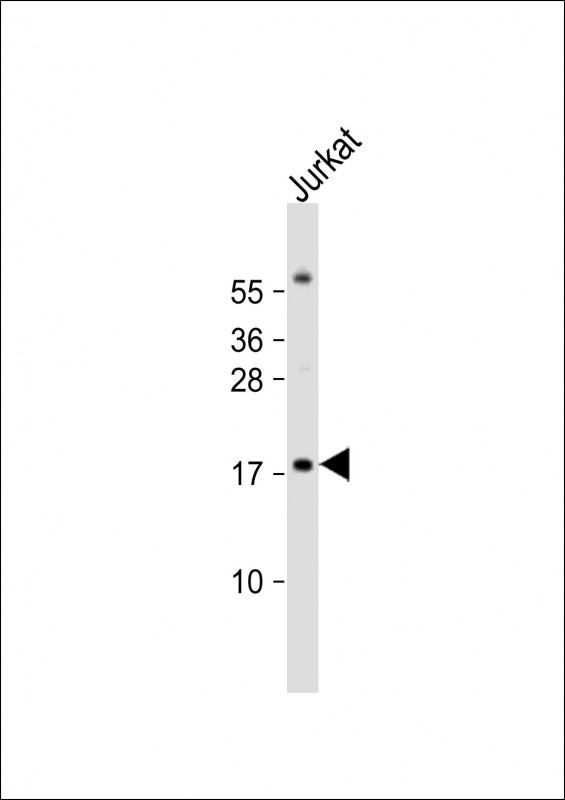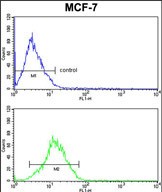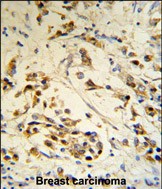



| WB | 1/1000 | Human,Mouse,Rat |
| IF | 咨询技术 | Human,Mouse,Rat |
| IHC | 1/100-1/500 | Human,Mouse,Rat |
| ICC | 技术咨询 | Human,Mouse,Rat |
| FCM | 咨询技术 | Human,Mouse,Rat |
| Elisa | 咨询技术 | Human,Mouse,Rat |
| Aliases | Putative RNA-binding protein 3, RNA-binding motif protein 3, RNPL, RBM3, RNPL |
| Entrez GeneID | 5935 |
| WB Predicted band size | 17.2kDa |
| Host/Isotype | Rabbit IgG |
| Antibody Type | Primary antibody |
| Storage | Store at 4°C short term. Aliquot and store at -20°C long term. Avoid freeze/thaw cycles. |
| Species Reactivity | Human |
| Immunogen | This RBM3 antibody is generated from rabbits immunized with a KLH conjugated synthetic peptide between 55-84 amino acids from the Central region of human RBM3. |
| Formulation | Purified antibody in PBS with 0.05% sodium azide,1%BSA and 50% glycerol.prepared by Saturated Ammonium Sulfate (SAS) . |
+ +
以下是关于RBM3抗体的3篇代表性文献的简要信息:
1. **文献名称**: *Cold-inducible RNA-binding protein (CIRP and RBM3) expression in human colorectal cancer*
**作者**: Sureban SM, et al.
**摘要**: 该研究通过免疫组化验证RBM3抗体的特异性,发现RBM3在结直肠癌组织中高表达,并与肿瘤侵袭性及患者预后相关,提示其作为潜在生物标志物的价值。
2. **文献名称**: *RBM3 mediates structural plasticity and protective effects of cooling in neurodegeneration*
**作者**: Peretti D, et al.
**摘要**: 利用RBM3抗体在神经元模型中研究低温诱导的RBM3表达,发现其通过维持突触可塑性减缓神经退行性病变,揭示了低温神经保护的分子机制。
3. **文献名称**: *Validation of antibodies for the specific detection of human RBM3 across applications*
**作者**: Uhlen M, et al.
**摘要**: 通过Western blot、免疫荧光等多平台验证多种RBM3抗体的特异性,为后续研究提供可靠的抗体选择依据,强调不同实验条件下抗体的适用性差异。
4. **文献名称**: *RBM3 expression is associated with improved survival in breast cancer*
**作者**: Jogi A, et al.
**摘要**: 研究采用RBM3抗体分析乳腺癌组织微阵列,发现RBM3高表达与患者总生存期延长显著相关,提示其可能作为乳腺癌预后的独立预测因子。
以上文献覆盖了RBM3抗体在癌症预后、低温保护机制及抗体验证等方面的应用,均为该领域经典研究。
The RNA Binding Motif Protein 3 (RBM3) antibody is a tool used to detect RBM3. a cold-inducible RNA-binding protein involved in stress response and cell survival. RBM3. part of the glycine-rich RNA-binding protein family, is encoded by a gene on chromosome 11 and contains an RNA recognition motif (RRM) domain. It plays roles in mRNA splicing, translation regulation, and stress granule dynamics. Initially identified for its induction during hypothermia, RBM3 is upregulated in response to cold shock, hypoxia, and other cellular stresses, where it promotes cell proliferation and inhibits apoptosis.
RBM3 antibodies are widely used in research to study its expression patterns in cancers (e.g., breast, prostate, colorectal) and neurodegenerative diseases. High RBM3 levels correlate with both tumor progression and improved prognosis, depending on cancer type, suggesting context-dependent roles. In neuroscience, RBM3 is linked to neuroprotection and synaptic plasticity, with potential therapeutic implications for Alzheimer’s and prion diseases.
Commercially available RBM3 antibodies (polyclonal/monoclonal) are validated for techniques like Western blotting, immunohistochemistry, and immunofluorescence. However, specificity challenges arise due to homology with related proteins (e.g., RBM4). Recent studies explore RBM3’s role in circadian rhythms and antiviral responses, expanding its biological relevance. Researchers rely on these antibodies to unravel RBM3’s dual roles in stress adaptation and disease pathways.
×